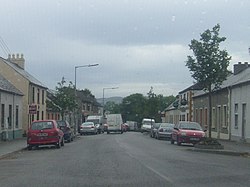|
Carrigans, County Donegal
Carrigans (Irish: An Carraigín, meaning 'little rock')[2] is a village in The Laggan, a district in the east of County Donegal, Ireland. The village is located on the R236 regional road, a short distance from the River Foyle. HistoryCarrigans was at one time[when?] the centre of a major flax and linen producing area, possessing one of the largest flax mills in County Donegal, before the demise of the flax industry in the 1950s.[citation needed] Commercial salmon fishing was also a major employer in the past.[citation needed] Killea (St. Fiach's) Parish Church (Church of Ireland) is in the village of Carrigans. [citation needed] Carrigans once had a railway station, the village being served by the Great Northern Railway, which closed in 1965.[citation needed] The Bangalore torpedo, an explosive device used in many conflicts, was invented by Captain (later Colonel) McClintock, of Dunmore, Carrigans. [citation needed] Carrigans was one of several Protestant villages in eastern Donegal that would have been transferred to Northern Ireland, had the recommendations of the Irish Boundary Commission been enacted in 1925.[3] Notable residents
See alsoReferences
External linksWikimedia Commons has media related to Carrigans, County Donegal. |
||||||||||||||||||||||||||||||


